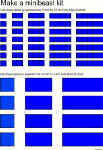Make a minibeast kit

Using the minibeast kit pupils can cut out the pieces they require. these can then be assembled on a blank piece of paper to produce prototypes of their design ideas.
Pupils should be encourages to experiment - how many body parts will you use? How many legs? Does it have to have only one head? etc. Get the children to record their ideas by 'prit' sticking the arrangements to blank paper.

The next stage is to build the chosen design. Emphasis should be placed on the pupils ensuring that the finished product matches the sizes and dimensions of the paper design.

